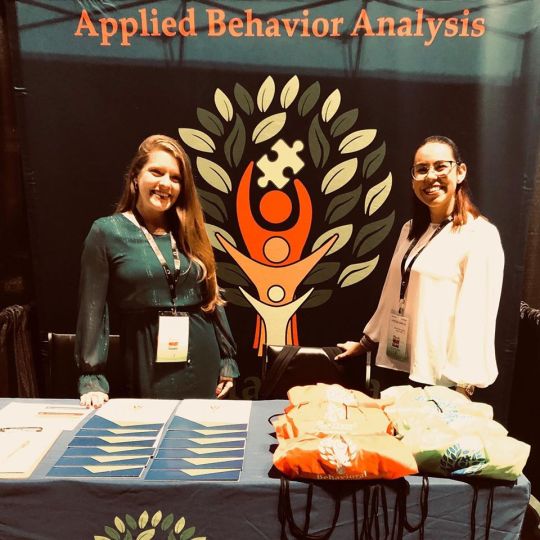#bcaba
Text

You have to change the environment to see real change.
#bcba#bcaba#mindfulness#mental health#self care#self improvement#education#psychology#meditation#bb community#self love#self help#positive quotes#life quotes#words#student life#study tips#behavior and cognition#behavior management#behavior change#applied behavior analysis
14 notes
·
View notes
Text
Hi everyone!
I'm currently enrolled in the ABA foundations course at Capella University and I'm on the lookout for someone who holds a BCBA certification to interview for an upcoming assignment. If you're a BCBA certified professional and are interested, please comment below and I'll get in touch with you. While I only need one participant, I'm hoping to conduct a few interviews to gather more information for my report. Thank you!
0 notes
Photo

A Perspective on Today’s ABA from Dr. Hanley This is today’s ABA when starting therapy with an autistic person, especially one who routinely engages in problem behavior. #Learnbylistening #compassion #aba #bcba #rbt #studayaba #bacb #bcaba https://practicalfunctionalassessment.com/2023/01/26/todays-aba-and-compassionate-care/ https://www.instagram.com/p/CpEK9SevK34/?igshid=NGJjMDIxMWI=
1 note
·
View note
Text
#Exam भी आ गए Date भी आ गयी | अब थोड़ी तैयारी करली जाये !#Get Personalized Learning Outcomes for everyone .#Give your FREE Mock Test Right Now ...#edunativeexamprep#ssccgl#sscexams#examprep#study#exampreparation#exam#education#exams#studygram#cat#currentaffairs#bcba#appliedbehavioranalysis#upsc#bcaba#gre#aba#examtime#behavioranalysis#bcbaexam#bcabaexam#boardexam#abaexam#testprep#examseason#bcbaexamprep
0 notes
Text
Pretty Girl - Eddie Munson x Reader
Note: This is for my darling @munson-blurbs 💚 I told her that if she finished the big project she was working on in time, I would write her anything she wanted. Not only did she finish on time, but she did it damn near perfectly. I am so unbelievably proud of you, Bug. I’m always in awe of your intelligence and work ethic. I hope I did justice to what you wanted, and I hope you all enjoy it as well! Also, I hope that I used the academic terms I included correctly, but if I didn’t, we’re just going to ignore that lol
Request/Summary: Eddie × Bookworm!Reader where Reader is stressed because of a massive project she has to do. And she keeps talking about all of this academic stuff that makes Eddie's head spin. So he does what he does best: fucks his smart girl until she's dumb
Warnings: smut, p in v, unprotected (wrap it up), oral f!receiving, slight daddy kink
Words: 2.4k

Eddie’s just hanging up the phone as you step into your shared apartment after a long day on campus. Letting out a huff, you drop your backpack down on the kitchen table, and books and papers come spilling out.
“Ugh,” you groan, running your hands down your face. Eddie frowns and walks over to the table as you slump down into a chair.
“What’s wrong, sweetheart?” he asks as he takes the seat across from you.
With a sigh, you shake your head. “S’nothing.” Eddie raises an eyebrow and tilts his head. You can practically hear him asking if you really expect him to believe that. “Just school bullshit. You’d think people studying for their doctorate would be a little more serious than some people in my class. But you don’t want to hear me ramble on.”
“Uh, yes, I do,” Eddie says, leaning forward on the table. “You know I think it’s sexy when you talk all academic. My girl’s gonna have her PhD.”
The salacious wiggling of his eyebrows has you cracking a smile. Relenting, you sit up in your seat and begin to tell Eddie about the irritants you’ve been dealing with.
“So, we have to utilize these things called literacy based behavior interventions…”
Eddie rests his chin on his fist as he listens to you. He’s picked up a lot over the years and is able to identify so many more words that you say than he used to. Sometimes though, he still gets a little confused.
“Well, then that brought us to the Social Identity Development Theory…”
Nodding, Eddie is almost positive he knows what that is, but he doesn’t want to interrupt you to double check.
“But after all this, he admits he doesn’t really understand qualitative vs. quantitative methodology! I have absolutely no idea how this man even became a BCABA.”
I know this one, Eddie thinks to himself. Board Certified Assistant Behavior Analyst.
“Then he kept saying ‘phenomenology’ instead of ‘pedagogy.’”
Now those, Eddie did not know. He can see you getting more riled up though, so he knows it’s time to intervene.
“Baby, baby, hey.” He reaches over and tugs on your hand, nodding for you to come over and sit in his lap. “It’s okay, you just need to relax.”
Reluctantly, you push yourself out of your chair and let Eddie pull you on top of him. The way he smirks up at you lets you know he’s about to get frisky even before his large hands slide up your thighs. Rough, calloused fingers dig into the plush of your denim covered legs.
“I think my smart girl needs me to take care of her, doesn’t she?” Eddie pouts up at you. When you nod in return, your boyfriend removes one hand from you and brings it back down to deliver a harsh smack to your ass. “Use your words, baby.”
A whimper escapes your throat as you tighten your legs around his hips. “Yes, Eddie. Need you. Make me feel better.”
Tightening his grip on you, Eddie stands up from the chair. A squeal escapes you as you tightly wrap your arms around his neck. A smirk of satisfaction on his lips, he carries you into your shared bedroom. Gently, he lays you down and lets you get comfortable before he’s crawling on top of you. Eddie tugs on the hem of your shirt, and you sit up enough for him to slide it off of you. Then he works down your body, taking off every piece of clothing in his path. Moving back up your body, he goes to press kisses against your neck, but you stop him with a yank on his own shirt.
“Me too?” he asks with a chuckle.
“Yes.” The adorable pout in your voice has Eddie acquiescing, stripping down so he’s just as naked as you are.
“May I continue?” After letting your eyes slowly roam up and down his bare body, you give him a nod of approval.
“You may.”
He chuckles and leans in and presses his lips against the juncture where your neck and shoulder meet. The kisses start off soft and sweet but turn wetter and needier as he moves down to your collar bones. Moving further down your body, he attaches his lips to the underside of your breast. It’s his favorite place to leave hickies on you and from the way his mouth is moving against the sensitive skin, you’re sure that’s what he’s doing now.
As the first moans tumble out of your mouth, Eddie switches breasts to give the other one the same attention. Your hands tangle in the curls that are splayed out over your naked chest, your fingers coming up to scratch at Eddie’s scalp as he continues his journey down your body. His kisses trail down your stomach, to your belly button, then further and further down until he stops just shy of where you most want his mouth.
“So needy,” Eddie says with a chuckle as your hips begin to move, looking for some sort of friction. You let out a whine and give a tug to Eddie’s hair. A guttural groan sounds deep in his throat. “Playing dirty, huh?”
“Need you so bad, Eddie,” you say through a whimper. The way you look down at him with wide, imploring eyes has his cock twitching between his body and the mattress.
“Relax, my beautiful little genius. I’m gonna help you feel better.”
You’re not given a chance to respond as Eddie moves down and wraps his lips around your clit. One of your hands comes out of Eddie’s hair to grip the sheet you’re lying on.
“Fuck,” you moan.
Eddie’s tongue expertly works over your clit, moving at the speed and pressure that he knows drives you wild. Using his hands to spread your legs even wider for him, he nudges his nose against your sensitive nub as he licks at your entrance.
“Jesus, baby, I’ll never get used to how fucking good you taste.” It’s not unusual for Eddie to take his time when he’s going down on you. He likes to ravish you, gathering every last drop from you that he can. The only reason he pulls away from your sopping pussy is to praise you on how sweet you taste or how wet you are for him.
Now, Eddie’s taking even more care than normal to make sure you’re feeling good. Lazy strokes of his tongue over your clit pairs with him slipping two fingers into you. The moment he curves them up inside of you, he’s hitting that delicious spot that has you seeing stars. There are few things Eddie knows better than your body—it’s the only thing he’s ever actually enjoyed studying. He knows it as well as he knows his own body and is able to bring you to the brink on his terms and in his time.
“M’close, Eddie.”
He knows without you telling him, though. You both know that. The way your walls clamp down around his fingers, the way your breaths hitch as you lose yourself in the feeling. With one last rub of his fingers against your inner wall, the wave of pleasure crashes over you and has you whining out your boyfriend’s name over and over again.
“That’s a good girl,” Eddie coos as he works you through your bliss. As your moans subside, he slips his fingers out of your pussy and pops them into his mouth. “Mm, fuck, baby.”
“Eddie,” you whine, trying to catch your breath.
“What, my princess?” He crawls up your body and presses gentle, barely-there kisses along the column of your throat. “You already cock drunk? I haven’t even been inside you yet, sweetheart.”
“Y’make me feel so good.” Your hands reach up, grabbing at any expanse of Eddie’s pale skin that you can.
“I’m here, baby,” he assures you, bringing a hand up to cup your cheek.
“Wanna feel you.”
“Aw, does my pretty girl want my PhD?” Eddie teases with a smirk. “My pretty huge dick?” Before you have time to respond, he leans down and slots his mouth over yours, immediately licking into your mouth. Using his other hand, Eddie lines himself up with your entrance and slowly pushes inside.
Eddie’s mouth swallows your moans as you feel him stretch you out deliciously. Above you, your boyfriend meets your sounds of pleasure with his own at the feeling of sliding into the wet warmth of your pussy.
“Shit,” Eddie mumbles against your mouth. “So fucking tight. This is all you needed, right baby? Just needed your daddy taking care of you.”
Words seem too hard as Eddie pulls his hips back before thrusting back into you again and again. You’re dissolved to whining and whimpering in response to his question, which has him smirking down at you.
“Mm, look at that,” Eddie muses as he grips your hip. “I may not be a genius like you, baby, but this I’m pretty good at. Fuck my smart girl ‘til she’s dumb.” Not only does Eddie know what to do to your body, but he knows just the words to say to get you hurtling towards another orgasm.
Every generous inch of Eddie moves inside of you, the ridge between the head and shaft dragging against all the spots that have you arching your back. A strong hand slides up from your hip, making sure to caress every inch of skin it comes across as it makes its way up to your mouth.
“Open up.”
Immediately, you do as you’re told, and Eddie slips two fingers into your mouth. Not needing to be told what to do with them, you begin to run your tongue around his fingers, swirling it around the tip as you soak the digits.
“God damn it,” Eddie says with a huff of laughter. “You’re gonna make me cum before I want to. Gotta get my girl off again, first.”
A small smirk on your face, you release his fingers with a pop. He reaches down and rubs his fingers over your clit, eliciting a breathy moan from your lips.
“That feel good, baby?” Eddie goads.
“Y-Yes,” you stutter, your eyes closing in ecstasy.
“Want you to cum for me again, my good girl. Think you can do that?”
“Yeah,” you breathe out. “So close.”
“Cum on my cock, baby. Want you to make such a mess of me. Cream my cock.”
“Fuck,” you groan, fingers digging into Eddie’s back as his thrusts become sloppier, a tell-tale sign he’s close as well. “Want you to cum too, Eddie.”
“Oh, don’t worry, princess,” he says with a laugh. “‘Bout to cum so hard in your pretty little pussy. Gonna fill you up so, so good. You’ll feel me dripping out of you for days.”
“Shit,” you hiss, and Eddie picks up the pace on your clit. “Fuck—E-Eddie, I’m gonna cum. Fuck, I’m coming.”
The clenching of your walls around his cock has Eddie losing his composure, groans and mutterings of your name falling from his tongue.
“Shit, baby—m-me too.”
Your bodies move together as the two of you ride out your highs with each other. Eddie’s head drops down and buries into your neck as his body stills on top of yours. Reluctant to pull out of you, Eddie busies himself by pressing sweet kisses against your skin.
“How was that, my love?” Eddie whispers against your ear.
“Was perfect,” you tell him, a lazy smile on your face. “Don’t want you to move.”
Eddie chuckles. “Me neither. But I was thinking we could get all comfy and I’ll hold you as close as you want me to.”
“Can’t get much closer than we are now,” you point out, making Eddie laugh again.
“Good point. I’m gonna get us cleaned up though, okay?”
Eddie forces himself to get out of the bed and brings back a warm washcloth. Gently, Eddie cleans you up before working on himself. He leaves the room to throw the washcloth in the hamper, but you figure he gets sidetracked because he takes longer than expected. When you see him balancing a bowl of popcorn and two bottles of water as he walks back into the room, you see why. He sets the snack down on the bed and rolls one of the water bottles your way.
“I was thinking,” he says, turning his back to you and walking over to the television resting on your dresser. “We should watch a movie.” It seems like he already had one in mind as he plucks one from your small pile of VHS tapes. Eddie pops the tape into the VCR and strolls back over to the bed. He holds the popcorn bowl so he doesn’t knock it over while he gets situated. As soon as he lifts his arm, you’re cuddling up into his side. Sweat sticks to both of you even after you’ve cleaned up, but you tuck yourself into Eddie’s side regardless. He places the bowl of popcorn on his thigh closest to you as you rest your head on his shoulder. The familiar sweet scent of your strawberry shampoo brings a smile to his face and a feeling of warmth and comfort settles over him.
“Oh, you put Tommy Boy on!” Your face lights up in glee as you point to the television, as if he didn’t know that you were referring to the movie on the screen.
“I know how much you love it,” he says, a smile on his face at how happy it made you.
Cuddling up to his side, Eddie grabs a few pieces of popcorn and holds them up to your mouth. Giggling, you eat them out of his hand like a horse being fed hay. The two of you lazily feed pieces to one another as you watch the movie. When the bowl is empty, you nuzzle your face into Eddie’s neck. The smell of sweat, weed, and his minty shampoo floods your senses and has you more relaxed than you’ve felt in days. Only a few minutes later, Eddie can feel your breath against his neck as it comes out in long puffs. A smile grows on his face at the realization that you’ve fallen asleep.
Carefully, Eddie moves the empty bowl of popcorn to the bedside table and slowly maneuvers himself so he's laying down, keeping you held in his arms. He pulls your body as close as he can, keeping his promise of holding you as closely as you’d like.
“Goodnight, pretty girl. I love you.”

#eddie munson#eddie munson x reader#eddie munson x y/n#eddie munson x you#eddie munson imagine#eddie munson fan fiction#Eddie Munson fic#eddie munson fanfic#request
954 notes
·
View notes
Text
youtube
ABA Inside Track Episode 231 | Emotional Behavioral Disorder Treatment with Dr. Johanna Staubitz
Dr. Johanna Staubitz is a BCBA-D who specializes in the treatment of emotional and behavioral disorders (EBD). While research on supporting students with EBD is still ongoing, Dr. Staubitz has been contributing with her own research and new technologies have shown to be promising for treatment.
During this podcast, she dives into a wide variety of related topics, such as self-control training for elementary students with EBD, minimizing escalation when treating dangerous problem behavior, and using behavior analytic procedures to treat EBD. She focuses on the behavioral perspective of emotional and behavioral disorders, detailing how manipulating the client's environment can be an excellent antecedent intervention when treating aggressive or otherwise inappropriate behavior.
This is an excellent listen for any registered behavior technician, BCaBA, or BCBA looking to expand their knowledge on working with clients with EBD.
0 notes
Text











Behavioral Family Solutions
13195 SW 134th St Ste. 201, Miami, FL 33186
786-206-6500
https://behavioralfamilysolutions.com/
Behavioral Family Solutions, in Miami, FL, is a private agency experienced in delivering the highest quality therapeutic services to children and their families since 2016. At BFS we provide applied behavior analysis by highly trained and skilled staff, such as Board Certified Behavior Analyst (BCBA), Board Certified Assistant Behavior Analyst (BCaBA), and Registered Behavior Technicians (RBT).
In following a multidisciplinary approach, we also provide cognitive behavioral therapy with services provided by highly trained and skilled Licensed Clinicians. We feel it is vital to our client’s progress to be able to address behavior and its environment as well as emotional components of the individual and family in order to obtain optimal progression of treatment. Services are provided in the community, at home, in schools, and at our state-of-the-art center locations.
#Autism#BCBA#BoardCertifiedBehaviorAnalysis#RBT#RegisteredBehaviorTechnician#ABATherapy#BehaviorAnalysis#ABATherapyNearMe#MentalHealthServices#AutismTherapy
1 note
·
View note
Text
Applied Behavior Analysis for Children With Autism

Applied behavior analysis (ABA) is a type of behavioral therapy that can be very effective for children with autism. The process involves a variety of therapeutic techniques that are tailored to the needs of each child. This type of therapy can improve a child's social skills, flexibility of learning, and academic skills. ABA can also enhance a child's independence. In addition to helping children with autism, ABA can be used in schools, hospitals, and other settings.
Applied behavior analysis combines principles of psychology with a range of techniques to help children learn and improve their social and academic skills. It has proven effective in treating autism and other developmental disorders for decades. While ABA is most often used in special education, it can be applied in a wide variety of contexts, such as everyday life, business, and animal training.
One of the most important principles in ABA is positive reinforcement. Using positive reinforcement, a therapist or other caregiver can reward a child for performing a task correctly. Positive reinforcement is more likely to be repeated than negative reinforcement. Besides boosting a child's chances of learning, it can also be a motivating factor.
Another ABA therapy strategy is the use of time-outs. These are designed to discourage harmful behaviors. Time-outs can be used to punish a child, but they can also be used to redirect and encourage a child. ABA focuses on behavioral strategies that are logically proven to help change a child's behavior. For example, a child may be rewarded for completing a task correctly by giving him or her a gold star or quiz. To know more about autism, visit this website at https://www.dictionary.com/browse/autistic.
ABA can also be used for adults with mental health issues and behavioral disorders. During the initial phase of ABA therapy, the analyst will conduct an assessment of the patient. The result of this assessment will be a Behavior Intervention Plan, or BIP. A BIP lists the problematic behaviors that should be addressed. During this phase, the team of BCaBAs will determine a treatment plan for the client. They will then match the client with a team of trained Interventionists. Get more helpful tips here!
During the course of ABA therapy, the child will be taught the different behavioral skills he or she needs to succeed. Skills such as communication, adapting to new situations, and social skills are critical for a person's well-being. During therapy, the child will have the chance to practice the skills he or she has been taught in group settings or one-on-one with a therapist. As the child's skill set grows, the goals in the BIP will be upgraded.
Applied behavior analysis can be a complex science. But it is well worth examining, especially if you are concerned about your child's behavior. If you have a child who has autism or another form of developmental disorder, seek out a therapist who has years of experience in ABA. Also, look for a practitioner who can show you videos of the desired behaviors. Seeing video demonstrations of how a behavior is done is often a more effective way to motivate a child. Be sure to go here!
0 notes
Text
Autism Remedy For Youngsters
Children with learning disabilities could need to work more durable and longer because of their disability. A proactive individual is ready to make choices and take action to resolve problems or obtain targets. For folks with learning disabilities, being proactive also involves self-advocacy and the willingness to take responsibility for decisions. Behavior Issues and Supports in Indiana This transient discusses issues surrounding habits challenges in instructional settings and supplies suggestions for enhancing practice. In this list, we have documented not only those who diagnose, assess, and/or treat an autism spectrum disorder but in addition present options for many who have or are suspected of getting a mental illness. Our website has useful info and assets together with visible supports, prognosis guides, roadmaps to state providers, summer season camps, recorded household assist webinars and extra.
She is keen about this subject and enjoys the people she’s worked with, including colleagues and households. Joanne pursued her BCaBA and later accomplished a master’s program in Applied Behavior Analysis on the Chicago School of Professional Psychology where she graduated in 2014 and obtained her BCBA. Joanne is constantly learning and grateful for having an opportunity autism learning centre to work within her group every single day. Mari Aceves, ED. D, DSW, BCBA acquired two doctorate degrees to support her work in ABA. She earned a doctorate in Educational Leadership with a P-12 emphasis and one in Social Work . She is a BCBA with over 10 years of expertise working with individuals with autism and other developmental disabilities.
The Adult Autism Center seeks to supply hands-on coaching and ABA therapy for people. These programs goal to give consideration to day by day dwelling, vocational abilities, and extra. Our children’s autism center’s therapy strategies are primarily based on the newest autism learning centre scientific strategies that lead to real results and hope. If your youngster is enrolled in a Michigan Medicaid well being plan, you have to be referred by your area people mental health agency. They offer diagnostic evaluations and quite a lot of other companies.
Behaviors focused for lower are behaviors that intrude with the learner’s capacity to function in their daily environment, keep relationships, and meet their primary wants. The principals of Applied Behavior Analyses are systematically utilized so as to design evidence-based interventions that reliably affect socially significant behaviors. Behavior knowledge is recorded day by day by the therapist and analyzed by the supervisor.
Kristi went on to complete her Master’s Degree in Psychology with an emphasis in Applied Behavior Analysis. She labored her means up to a supervisory position and earned her board certification in 2016. Kristi has worked primarily with youth and adolescence and also has some extra autism learning centre experience working with grownup populations in group houses. She enjoys teaching others ABA and has devoted herself to enhancing the standard of services delivered to our shoppers.
0 notes
Text
aetna aba credentialing

aetna aba credentialing
Why get insurance credentialing from the ABA?Simply put, one good reason for an ABA therapist to undergo ABA therapy insurance credentialing is to treat patients who have ABA health insurance coverage from particular health insurance companies.The following are additional possibilities: united healthcare
A Population with Autism Spectrum Disorder At least 3.5 million people in the United States currently have an autism spectrum disorder.The numbers suggest that there will soon be a demand for ABA therapists with the skills and credentials needed to treat the sick.Better Customer Service Because many insurance companies now have their own team of autism specialists, in-network providers like licensed ABA therapists can socialize and build valuable relationships within the company that can speed up the process of resolving claims or help with questions about claims. aba credentialing
Pre-authorization, re-authorization, and online claims information are made possible by this.In the end, clinics are able to provide better customer service because of all of these factors.Consistent Work's ability to bring a medical practice onto an insurance panel or, even better, make them an in-network provider is probably one of its most significant advantages.This makes it possible to consistently deal with billing codes, rates, and other reports and deliverables.
businesses may be able to make important decisions more effectively and efficiently as a result of the system's overall uniformity.Electronic Billing When a medical practice is credentialed, it can send insurance providers electronic bills.When compared to traditional paper forms, electronic claims are quicker and more convenient ways to quickly receive payments.Unfortunately, medical practices that do not meet the necessary credentialing requirements cannot take advantage of this benefit.
The Credentialing Procedure The ABA credentialing procedure is difficult.The entire procedure can take anywhere from 90 to 120 days to complete.The credentialing process should be started as soon as possible, particularly for new medical practices.It is highly recommended that you seek the assistance of third-party support like DENmaar, which can complete the task on your behalf, due to its length and complexity.
The procedure for obtaining ABA Insurance Credentials is as follows: Medical practices must first apply for an NPI, or National Provider Identifier, in order to become credentialed.Information such as a social security number, BCBA certificate number or BCaBA certificate number, Taxonomy code for behavioral analysts, and BA license number, if applicable, must be entered into an online application.
The NPI, which can typically be obtained within a day, is necessary for any carrier to reimburse for ABA services.The next thing to do is join The Council for Affordable Healthcare after acquiring NPI.CAQH can only include a medical practice.The insurance company must issue an invitation to the medical practice.Once the company is able to access the CAQH system, it must submit a plethora of documents, including a resume, references, employment history, W-9, BCBA or BCaBA certificates, educational history, and information about medical practice.Insurance companies will have access to the provided data once the application is completed.They will use the data to check with their company.
0 notes
Text
Tweeted
Participants needed for online survey! Topic: "A Survey on Mindfulness in Behavior Analysis" https://t.co/pvwELv2qnO via @SurveyCircle #mindfulness #BehaviorAnalysis #bcba #bcaba #meditation #PrivateEvents #survey #surveycircle https://t.co/8cjV677YWq
— Daily Research @SurveyCircle (@daily_research) Sep 17, 2022
0 notes
Video
youtube
A BCaBA Discusses Mental Wellness and Behavior :: "The Male Perspective"...
0 notes
Text
Applied Behavior Analysis Guide

Most positions as an applied behavior analyst require at least a master's degree in a related field. Typical undergraduate degrees in psychology or a related discipline, such as animal science, lay a solid foundation for graduate school programs. Volunteering for an organization that utilizes applied behavior analysis is a good way to gain valuable experience and prepare for the field. The ABA career field is rapidly expanding. The growth of the field will continue to grow and the demand for ABA therapists will only continue to increase. Click on this link to get the perfect ABA therapist.
An effective learning plan will use things that motivate the child. The therapist may start by teaching a child to say the word blue, and then reward him or her for doing so. These steps can be more digestible for the child with autism, especially if they are paired with a reinforcing item. In addition to rewarding the child for a behavior, the therapist may play with the child for part of the first session.
When applying applied behavior analysis to an individual's case, the therapist first understands the underlying cause of the problem. Then, he or she will work to change the antecedent to achieve the desired behavior. An example of this method is the ABC method. The therapist will present the client with a picture of an item, such as a bright toy, and ask the patient to exchange the picture for the object. The therapist in this company will encourage communication and interaction to get the desired item.
There are many types of applied behavior analysis, including those for autism. A Board Certified Behavior Analyst (BCBA) is a professional who specializes in the treatment of children with autism and supervises the work of other professionals. In addition to their own professional work, BCBAs often supervise the work of Board Certified Assistant Behavior Analysts (BCaBAs) and Registered Behavior Technicians. ABBAs are the highest-level certified practitioners in the field.
The ABA process is critical to the success of this treatment. Practitioners of ABA are guided by a systematic, observable course of treatment. The method is also logically evaluative. Scientific observation is essential to behavior therapy since it has been around since its origins. Its early proponent, B.F. Skinner, put his theories to the test using the famous Skinner Box. These experiments were designed to test the theories of behavioral analysis.
Applied behavior analysis is a highly successful treatment for autism. A number of state and federal agencies have approved the therapy, including the American Academy of Pediatrics and the New York State Department of Health. Several studies have shown that ABA can help children with autism develop skills that lead to a productive life. It's not only effective for children with autism, but it can also help develop complex skills. There are several benefits of ABA therapy, but it's best to choose the right approach for your child.
Keep reading on: https://www.britannica.com/topic/human-behavior and most importantly, convert your knowledge into action, otherwise it remains a source of untapped energy as well as wasted potential.
0 notes
Text
The Applied Behavior Analysis

Applied behavior analysis therapy uses psychological techniques to modify specific behaviors. The treatment process begins with a diagnosis. Then, the therapist will focus on changing specific behaviors. Children in this therapy may feel they are not being understood during therapy sessions. Some people may think that the child should change in order to fit in socially or to be more adaptable to people on the spectrum. However, these ideas are not supported by the research and may actually harm the child's wellbeing.
In addition to teaching an individual how to use applied behavior analysis therapy, an online master's program is available. Applied coursework and hands-on practice are combined in this program to teach prospective therapists the principles of the therapy and its methods. ABA therapy courses include topics such as behavioral theories, treatment techniques, and ethical practices. Students may choose a combination of online and campus programs to meet their individual career goals. Aba therapy frisco specializes in an area like early childhood education and become university professors.
Applied behavior analysis (ABA) is a scientific technique used to treat individuals with developmental disabilities. Using principles from learning theory, it aims to teach an individual to communicate in appropriate ways and improve their social skills. In schools and businesses, it helps increase productivity by improving work flow and promoting positive behaviors. As a result, ABA therapy has made its way into many different environments. Some of its key principles include using positive and negative reinforcement to modify the environment.
Applied behavior analysis is a proven method of treatment for autism. A number of federal and state agencies have endorsed the therapy, including the U.S. Surgeon General. It has helped many people with autism lead normal lives, including enhancing social skills and increasing IQ levels. If you are considering an ABA therapy program for your child, the first step is to find a qualified therapist who specializes in autism. They will be able to best guide you through the program.
ABA aims to change these behaviors by reversing the effects of unwanted behavior. It relies on positive reinforcement to encourage desired behavior and discourage negative behavior. It also focuses on understanding antecedents and consequences of behaviors. Once a child understands how these consequences work, it is easier to change them. Hence, ABA therapy works to improve a child's life and improve their self-esteem. With this, parents should be aware of the importance of ABA therapy. Click here: https://aparaautism.com/aba-therapy-pearland/ to ledarn more about the benefits of Applied behavior analysis.
The ABA program is a comprehensive program designed to address the specific needs of each child. A team of BCBAs or BCaBAs will assess a child's needs and skill levels to develop a treatment plan tailored to their individual needs. The team will use a multi-disciplinary approach that allows for individual attention and the best outcome for the child. However, no two clients are the same. During the course of the treatment, a Behavior Interventionist will work one-on-one with the child and parents will receive training on how to implement the program. Find out more details in relation to this topic here: https://en.wikipedia.org/wiki/Applied_behavior_analysis.
0 notes
Photo

¡Hola, bellas almas!
Ha pasado un tiempo desde mi última publicación en el blog, ¿verdad? ¡Pero buenas noticias! ¡Volví!
Para celebrar el 15.° Mes Mundial del Autismo, ahora este abril, y el anterior Día Mundial de Concientización sobre el Autismo, el pasado 2 de abril, ¡nuestro próximo tema es el Trastorno del Espectro Autista!
¿Qué es el Trastorno del Espectro Autista?
Según el sitio web Autism Speaks, el trastorno del espectro autista o ASD se refiere a una amplia gama de condiciones caracterizadas por desafíos con las habilidades sociales, comportamientos repetitivos, habla y comunicación no verbal. El autismo afecta aproximadamente a 1 de cada 44 niños en los Estados Unidos.
El TEA es una condición de desarrollo compleja que involucra desafíos persistentes con la comunicación social, intereses restringidos y comportamiento repetitivo.
No existe un autismo sino muchos subtipos influenciados principalmente por factores genéticos y ambientales. Debido al hecho de que el autismo es un trastorno del espectro, cada persona con autismo tiene un conjunto distinto de fortalezas y desafíos. Por lo tanto, las personas con autismo pueden variar desde muy hábiles hasta severamente desafiadas en las habilidades de aprendizaje, pensamiento y resolución de problemas.
La mayoría de las personas autistas desafiantes pueden necesitar un apoyo significativo en su vida diaria. Este apoyo puede ser RBTs, BCaBAs, BCBAs, Logopedas, Terapeutas ocupacionales, etc.
Diagnóstico
El diagnóstico de ASD puede ser difícil porque no existe una prueba médica para diagnosticar el trastorno, como un análisis de sangre. El TEA se puede diagnosticar observando el historial de desarrollo y el comportamiento del niño.
Los padres, cuidadores o pediatras pueden notar algunos signos y síntomas de ASD antes de que la persona cumpla un año o tan pronto como 18 meses. Sin embargo, los signos y síntomas del TEA suelen aparecer a los 2 o 3 años.
¿Qué condiciones se consideran TEA?
* Síndrome de Asperger o trastorno del espectro de nivel 1: extremo más leve del TEA. Un niño con Asperger puede ser brillante y capaz de manejar su vida diaria. Pueden centrar su atención en temas que les interesen y discutirlos sin parar. Sin embargo, tienen dificultades para socializar.
* Síndrome de Rett: raro trastorno del neurodesarrollo que afecta principalmente a niñas. Sin embargo, se puede diagnosticar en niños. Presenta desafíos que afectan casi todos los aspectos de la vida de un niño. El niño aún puede disfrutar y vivir una vida plena con el cuidado adecuado, como pasar tiempo juntos en familia o brindar apoyo para permitir que el niño haga lo que quiera.
* Trastorno desintegrativo infantil: la parte más rara y grave del TEA. Describió a niños que se desarrollan normalmente y luego pierden rápidamente muchas habilidades sociales, del lenguaje y mentales, generalmente entre los 2 y los 4 años. A menudo, estos niños desarrollan un trastorno convulsivo.
* Síndrome de Kanner o trastorno autista clásico: un niño con síndrome de Kanner parece atractivo, alerta e inteligente con características subyacentes de la afección, como falta de vínculo emocional con los demás, problemas de comunicación e interacción, habla descontrolada, obsesión por manipular objetos, alto grado de memoria memorística (memorización de información basada en la repetición) y habilidades visuoespaciales (capacidad de identificar la relación visual y espacial entre las cosas) con importantes dificultades de aprendizaje en otras áreas.
* Trastorno generalizado del desarrollo (PDD-NOS): un niño con algunas pero no todas las características de ASD o que tiene síntomas relativamente leves. El niño puede tener síntomas significativos de autismo en un área central, como deficiencias sociales, o síntomas leves o nulos en otra área central, como conductas restringidas o repetitivas.
Signos y síntomas
La comunicación e interacción social puede incluir:
* Evite o no mantenga el contacto visual.
* No responda al nombre a los nueve meses de edad.
* No muestre expresiones faciales (feliz, triste, enojado o sorprendido) a los nueve meses de edad.
* No juegue juegos interactivos simples a los doce meses de edad.
* Use pocos o ningún gesto (despedirse) a los doce meses de edad (1 año)
* No comparta intereses (muestre su juguete favorito con otros) a los quince meses de edad.
* No señalar para mostrarle a alguien algo interesante a los dieciocho meses de edad (1 año y seis meses)
* No se dé cuenta cuando otros estén heridos o molestos a los veinticuatro meses de edad (2 años)
* Pasar por alto a otros niños y unirse a ellos para jugar a los treinta y seis meses de edad (3 años)
* No pretenda ser otra cosa, como jugar a ser maestro, médico o superhéroe a los cuarenta y ocho meses de edad (4 años).
* No cantar, bailar o actuar para alguien a los 60 meses de edad (5 años)
Los comportamientos e intereses restringidos o repetitivos pueden incluir:
* Alinea los juguetes u otros artículos y se molesta cuando se cambia el orden
* Repetir palabras o frases una y otra vez (ecolalia)
* Juega con juguetes de la misma manera cada vez
* Centrarse en partes de un artículo (ruedas de un coche de juguete)
* Enojarse por cambios menores
* Tener intereses obsesivos
* Debe seguir ciertas rutinas
* Agitar las manos, balancear el cuerpo o girar en círculos
* Tiene reacciones inusuales a la forma en que las cosas suenan, huelen, saben, se ven o se sienten.
Otras características que la mayoría de las personas con TEA pueden tener incluyen:
* Retraso en el lenguaje, el movimiento, las habilidades cognitivas o de aprendizaje
* Comportamiento hiperactivo, impulsivo y desatento.
* Trastorno de alimentación inusual o convulsiones
* Estado de ánimo único o reacciones emocionales
* Ansiedad, estrés o preocupación excesiva
Tratamiento
Aunque el TEA no tiene una "cura", existen varias intervenciones efectivas para mejorar el funcionamiento del niño:
* Análisis de comportamiento aplicado (ABA): implica un estudio sistemático de los desafíos funcionales de un niño
* Terapia del habla y del lenguaje: mejora los patrones del habla y la comprensión del lenguaje del niño
* Terapia ocupacional: aborde los déficits de habilidades adaptativas con actividades de la vida diaria y problemas con la escritura a mano
* Servicios de educación especial: bajo un Plan de Educación Individual proporcionado por la escuela, que se adapta a los déficits de comunicación social, intereses restringidos y comportamientos repetitivos del niño. Estos servicios incluyen clases diurnas especiales para la primera infancia para abordar el lenguaje, las habilidades sociales y para la vida.
0 notes
Photo

Hello, beautiful souls!
It has been a while since my last blog post, right? But great news! I'm back!
To celebrate the 15th annual World Autism Month, now this April, and the previously World Autism Awareness Day, last April 2nd, our next topic is Autism Spectrum Disorder!
What is Autism Spectrum Disorder?
According to the Autism Speaks website, Autism Spectrum Disorder or ASD refers to a broad range of conditions characterized by challenges with social skills, repetitive behaviors, speech, and nonverbal communication. Autism affects about 1 in 44 children in the United States.
ASD is a complex developmental condition involving persistent challenges with social communication, restricted interests, and repetitive behavior.
There is not one autism but many subtypes influenced mainly by genetic and environmental factors. Due to the fact autism is a spectrum disorder, each person with autism has a distinct set of strengths and challenges. Therefore, people with autism can be ranged from highly skilled to severely challenged in learning, thinking, and problem-solving skills.
Most challenging autistic people may require significant support in their daily lives. This support can be RBTs, BCaBAs, BCBAs, Speech therapists, Occupational therapists, etc.
Diagnosis
Diagnosing ASD can be difficult because there is no medical test to diagnose the disorder, such as a blood test. ASD can be diagnosed by observing the child's developmental history and behavior.
Parents, caregivers, or pediatricians can notice some signs and symptoms of ASD before the person reaches one year old or as early as 18 months. However, signs and symptoms of ASD usually appear at age 2 or 3.
What conditions are considered ASD?
Asperger's syndrome or level 1 spectrum disorder: milder end of ASD. A child with Asperger's may be brilliant and able to handle their daily life. They can focus their attention on topics that interest them and discuss them nonstop. However, they have difficulty socializing.
Rett syndrome: rare neurodevelopmental disorder mainly affects girls. However, it can be diagnosed in boys. It presents challenges that affect almost every aspect of a child's life. The child can still enjoy and live a fulfilling life with the proper care, such as family time together or providing support to allow the child to do what they want.
Childhood disintegrative disorder: rarest and most severe part of ASD. It described children who develop typically and then quickly lose many social, language, and mental skills, usually between 2 to 4 years old. Often, these children develop a seizure disorder.
Kanner's syndrome or classic autistic disorder: a child with Kanner's syndrome appears attractive, alert, and intelligent with underlying characteristics of the condition such as lack of emotional attachment with others, communication and interaction challenges, uncontrolled speech, obsession with handling items, high degree of rote memory (memorization of information based on repetition) and visuospatial skills (capacity to identify the visual and spatial relationship among things) with significant difficulties learning in other areas.
Pervasive developmental disorder (PDD-NOS): a child with some but not all characteristics of ASD or who has relatively mild symptoms. The child may have significant autism symptoms in one core area, such as social deficits, by mild or no symptoms in another core area, such as restricted or repetitive behaviors.
Signs and symptoms
Social communication and interaction can include:
Avoid or do not keep eye contact.
Do not respond to name by nine months of age.
Do not show facial expressions (happy, sad, angry, or surprised) by nine months of age.
Do not play simple interactive games by twelve months of age.
Use few or no gestures (wave goodbye) by twelve months of age (1 year)
Do not share interests (show favorite toy with others) by fifteen months of age.
Do not point to show someone something interesting by eighteen months of age (1 year and six months)
Do no notice when others are hurt or upset by twenty-four months of age (2 years old)
Overlook other children and join them to play by thirty-six months of age (3 years old)
Do not pretend to be something else, like play to be a teacher, doctor, or superhero by forty-eight months of age (4 years old)
Do not sing, dance, or act for someone by 60 months of age (5 years old)
Restricted or repetitive behaviors and interests can include:
Line up toys or other items and gets upset when order is changed
Repeat words or phrases over and over (echolalia)
Play with toys the same way every time
Focus on parts of an item (wheels of a toy car)
Get upset by minor changes
Have obsessive interests
Mus follow certain routines
Flap hands, rock body, or spin self in circles
Have unusual reactions to the way things sound, smell, taste, look or feel
Other characteristics most people with ASD can have include:
Delayed language, movement, cognitive, or learning skills
Hyperactive, impulsive, and inattentive behavior
Unusual eating or seizure disorder
Unique mood or emotional reactions
Anxiety, stress, or excessive worry
Treatment
Even though ASD does not have a "cure," there are several effective interventions to improve the child's functioning:
Applied behavior analysis (ABA): involves a systematic study of a child's functional challenges
Speech & language therapy: improve child's speech patterns and understanding of language
Occupational therapy: address adaptive skills deficits with activities of daily living and problems with handwriting
Special education services: under an Individual Education Plan provided by the school, which accommodates the child's social communication deficits, restricted interests, and repetitive behaviors. These services include special day classes for early childhood to address language, social, and life skills.
0 notes